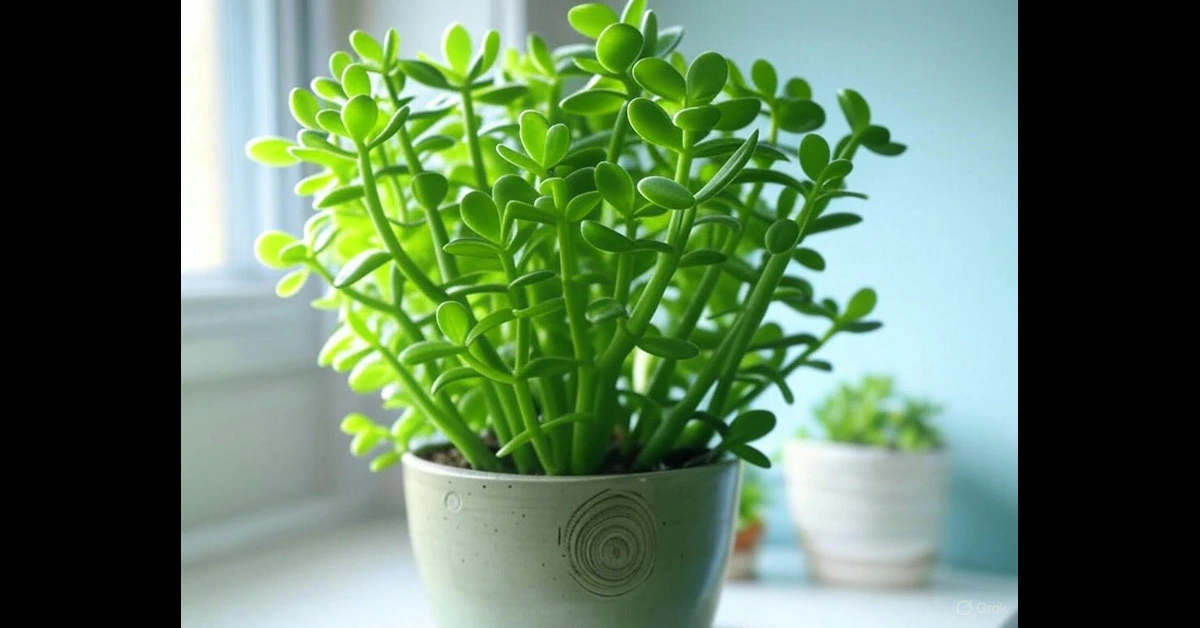How to Take Care of a Jade Plant Indoors & Outdoors – Jade plants are hardy succulents that can thrive in both indoor and outdoor environments with proper care. They require bright, indirect sunlight, well-draining soil, and proper watering to stay healthy and grow strong. With the right conditions, jade plants can live for years, making them a perfect low-maintenance addition to any home or garden.
As someone with years of experience in gardening and farming, I’ve grown and cared for many jade plants. Through trial and error, I’ve learned the best practices for keeping them thriving in any environment. In this guide, I’ll share everything you need to know about jade plant care, including light requirements, best soil, watering, fertilization, and common problems with solutions.
Table of Contents
How to Take Care of a Jade Plant 2025
The jade plant (Crassula ovata) is an easy-to-grow succulent, perfect for both indoor and outdoor spaces. To keep it healthy, place it in bright, indirect sunlight, use well-draining soil, and water only when the soil is dry. Overwatering can cause root rot, so always let excess water drain out. Fertilize once a month during the growing season for better growth. If you notice yellow leaves or wrinkled stems, adjust watering and light conditions. By following these simple jade plant care tips, you can enjoy a thriving, long-lasting plant.
Jade Plant Light Requirements
Indoor Jade Plant Light Needs
Jade plants love sunlight, but too much direct exposure can harm them. Here’s what works best:
✅ Place it near a south or west-facing window for 4-6 hours of bright, indirect sunlight.
✅ If your home lacks natural light, consider using a grow light.
✅ Avoid dark corners—jade plants struggle in low-light conditions.
Outdoor Jade Plant Light Needs
If you’re growing jade outdoors, keep these points in mind:
✅ It thrives in partial to full sunlight, but morning sun and afternoon shade is ideal.
✅ Too much direct sunlight, especially in hot climates, can scorch the leaves.
✅ If transitioning from indoors to outdoors, gradually increase sun exposure to avoid shock.
🔗 how to take care of jade plant in Summer
Best Soil for a Jade Plant
From my personal experience, the biggest mistake people make is using the wrong soil. Jade plants hate soggy roots! The best soil mix should be:
✅ Well-draining – prevents root rot.
✅ Sandy or gritty – allows air to reach the roots.
✅ Low in organic matter – avoids moisture retention.
Recommended Soil Mix:
- 60% potting soil
- 20% perlite (or pumice)
- 20% coarse sand
If you’re using store-bought soil, go for a cactus or succulent mix.
Jade Plant Watering Guide
Watering a jade plant is all about balance—too much, and the roots rot; too little, and the leaves shrivel.
✅ How often to water?
- Summer: Once every 1-2 weeks, depending on humidity.
- Winter: Once every 3-4 weeks (jade plants grow slowly in cold months).
✅ How to check if it needs water?
- Stick your finger 1-2 inches into the soil. If it’s dry, it’s time to water.
- Leaves feeling soft or wrinkled? That’s a sign of dehydration.
Common Mistake: Overwatering! If you see yellow leaves or mushy stems, reduce watering immediately.
Best Fertilizer for a Jade Plant
Jade plants don’t need frequent feeding, but the right fertilizer can boost their growth.
✅ Use a balanced fertilizer like 10-10-10 or 20-20-20, diluted to half strength.
✅ Feed once a month during the growing season (spring & summer).
✅ Skip fertilizing in winter, as the plant’s growth slows down.
For an organic approach, I recommend compost tea or diluted fish emulsion—these have worked wonders for my jade plants!
Common Jade Plant Problems & Solutions
Even with the best care, jade plants can face some common issues. Here’s how to fix them like a pro:
1. Yellowing Leaves
Cause: Overwatering or too much direct sunlight.
Fix: Let the soil dry completely before watering again and move to indirect sunlight.
2. Wrinkled or Shriveling Leaves
Cause: Underwatering or excessive heat.
Fix: Water the plant deeply and avoid keeping it in extreme heat.
3. Soft, Mushy Leaves
Cause: Root rot from overwatering.
Fix: Remove affected leaves, let the soil dry, and repot if necessary.
4. Leaf Drop
Cause: Sudden temperature changes, watering issues.
Fix: Keep in a stable temperature (15-24°C) and water only when needed.
5. Brown Spots or Scorching
Cause: Sunburn or fertilizer burn.
Fix: Move to partial shade and dilute fertilizer before applying.
6. White Powdery Coating on Leaves
Cause: Powdery mildew (common in high humidity).
Fix: Improve air circulation and clean leaves with a neem oil solution.
7. Pests (Mealybugs, Spider Mites)
Cause: Poor air circulation or over-fertilization.
Fix: Wipe leaves with neem oil or a cotton swab dipped in alcohol.
Final Jade Plant Care Tips
✅ Use a pot with drainage holes to prevent water buildup.
✅ Rotate the plant occasionally for even growth.
✅ Dust off the leaves to keep them healthy and shiny.
✅ Prune leggy stems for a compact, bushy shape.
I’ve been growing jade plants for years, and I can tell you—once you get the basics right, they’re one of the easiest plants to maintain!
Can a jade plant survive in low light?
It can tolerate low light, but it grows best in bright, indirect sunlight
Why are my jade plant leaves wrinkled?
That’s usually a sign of underwatering. Water thoroughly and check soil moisture regularly.
Should I mist my jade plant?
No, misting can increase humidity and cause fungal issues. Jade plants prefer dry air.
Conclusion
Taking care of a jade plant is simple when you provide the right light, soil, and watering schedule. Avoid overwatering, use well-draining soil, and place it in bright, indirect sunlight for healthy growth. For more detailed tips on how to take care of a jade plant, visit TakeCarePlant.com and explore expert gardening advice. Happy growing
Read more Post
